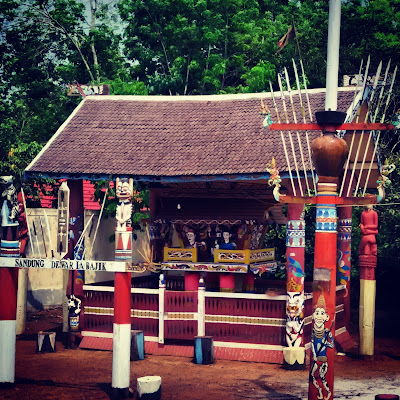Dayak tribes, is one of the many
tribes in Indonesia which put death rituals at the most high in the order of
culture. Death is regarded as the beginning of a long journey towards sebayan
(nature after life/saruga/heaven ~ dayak people ignorant of the existence of
hell). So that people who die, should be given enough stock, provided the media
a long journey as well as a good place to live. It is provided by the families
who are still living.
Death rituals, in addition to
delivering souls final resting place, University of Regensburg, unconsciously
has become such a show of strength (show of force) by families who are still
living, is due to perform the ritual of appointment/transfer of the framework
of the deceased from the grave into Sandung cost does little, time rituals
(they call it a party) for a little over a full week, day and night.
Sandung…
Sandung, generally made of Ulin
wood (Eusideroxylon zwageri), often also called Tebelian wood, wood or iron
Proof. To get the ulin wood with a diameter of 60 cm above the pretty hard and
it took a large charge, besides Sandung is generally accompanied with different
types of carvings and only certain people can do it, because the carvings were
not made arbitrarily, there are certain conditions that must be met, as if one
may give rise to a kind of bala (the author or the family, can be possessed
could even cause death), I understand the purpose of the existence of a true
army, to defend the sacredness of the carving with do not allow just anyone to
carve it.
The ritual of the appointment
framework of the deceased and move it to the Sandung called TIWAH (kalteng) and
in some places in West Kalimantan is colloquially known as ngensudah, not
everyone is able to execute the dayak tiwah, which is why at the tiwah raised
not only a framework, but it can be a family or some framework, this is done to
a very high cost.
Read More About TIWAH-->>>
Read More About TIWAH-->>>
At this time, especially since
the entry of the Catholic Religion take it by Protestant Christian
missionaries, by Zending, and the spread of Islam by arab traders, the ritual
has begun to be abandoned, it is now more modest death event, tiwah no longer
lift the frame of the deceased but simply marked by doing advanced hardening
like cementing or installing ceramic on the Tomb. This way is considered enough
to do homage to the deceased while not aggravating the family left behind.
Ngensudah, it could mean an end
to the relationship between the dead with the living. This ritual is a form of
simplification of tiwah, implementation time generally after forty days or so
since the death. In this event generally marked with beautifying the tomb with
cementing or installing ceramic and slaughter of livestock in the form of Sandung
as much as 1 (one) tail. At this event, all the residents of the village and
the surrounding villages are invited. It is important to note, before the event
ngensudah is implemented, the wife or husband of the deceased was forbidden to
seek a new life partner.


No comments:
Post a Comment